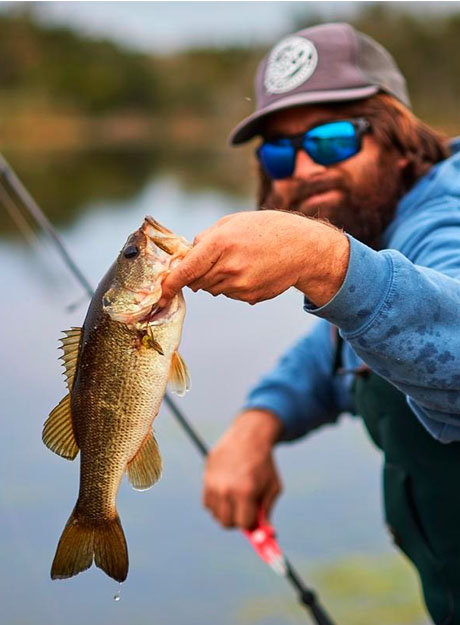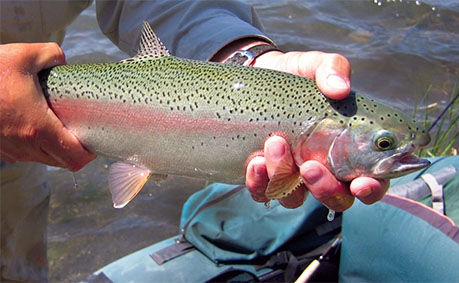Largemouth bass live in lakes, rivers, and waterways throughout North America. They are often found near underwater cover including thick weeds, lily pads and sunken objects. Effective methods for catching largemouth bass are bait casting, drift fishing, fly fishing and a unique technique called “dragging”.
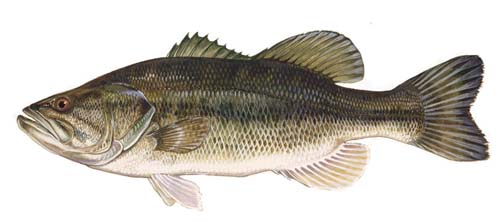
Habitat: Lake, Pond
The following guide provides angling information, tips and techniques to help you have fun and productive largemouth bass fishing experience.
- How to identify Largemouth Bass
- Where to catch Largemouth Bass
- Largemouth Bass Habitat by Season
- When to fish Largemouth Bass
- How to catch Largemouth Bass
- Best Lures, Bait & Tackle for Largemouth Bass
How to identify Largemouth Bass
Largemouth bass look very similar to smallmouth bass and other species of black bass (e.g. Redeye, Spotted, etc.) They are distinguishable from similar species by a large slightly slopped mouth that extends nearly to the rear of the eye. There is also a noticeable deep dip separating the first and second dorsal fins.
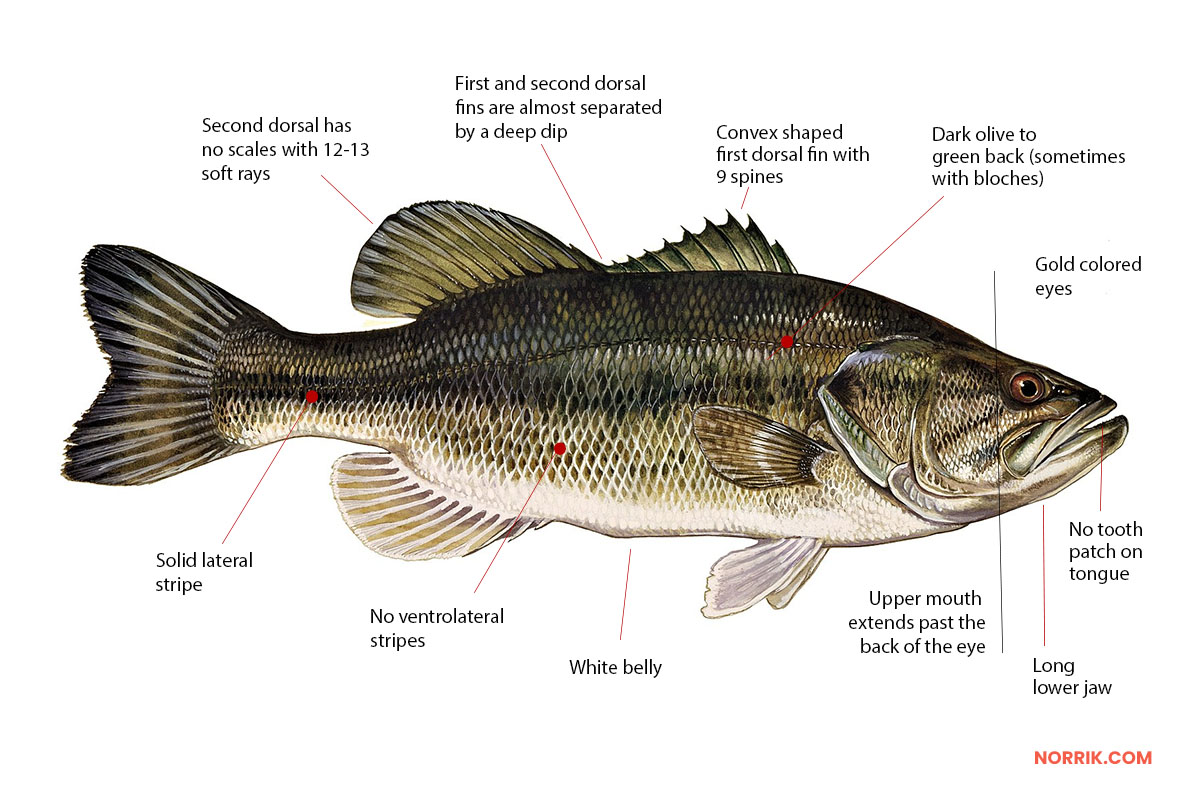
Largemouths are typically green or olive-green with dark, horizontal markings along their sides. Dorsal fins have soft rays, and the tail is slightly forked. As a largemouths age, their coloring tends to becoming darkering. Largmouth bass in murky water may become dark brown or nearly black.
Largemouth bass average from 1 to 4.5 pounds and 12 to 24 inches. The largest largemouth bass on record was 22 pounds and 4 ounces, captured by George Perry on Montgomery Lake in Georgia in 1932. While not common, every year anglers reel in a few largemouth bass in the 10 to 20 pound range.
Where to catch Largemouth Bass
These fish can be found throughout the U.S., though the largest populations of largemouths is in the southern and eastern United States. Because they are a popular game fish, they’ve been introduced around the world and can now be be found in Asia, Europe, South America, Central America, and Africa.
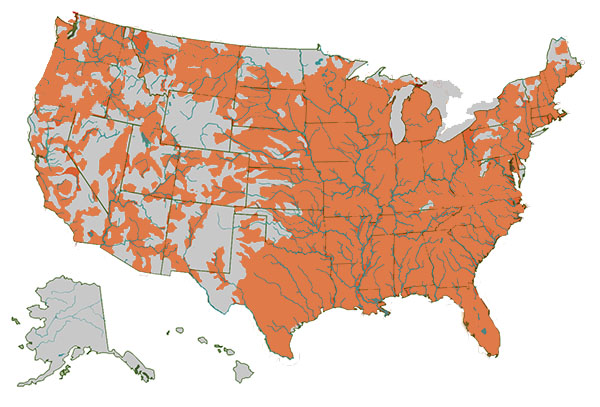
Largemouth bass live in freshwater lakes, rivers, and waterways, though they are most common in shallow lakes, ponds and the backwaters of pools. They also live in brackish (a mix of fresh and saltwater) waters. Their preferred habitat is vegetation with thick weeds or near sunken objects that provide cover where they can escape predation and ambush prey. Fishing along vegetation, under lilypads, and near structure is where you’re most likely to get a bite.
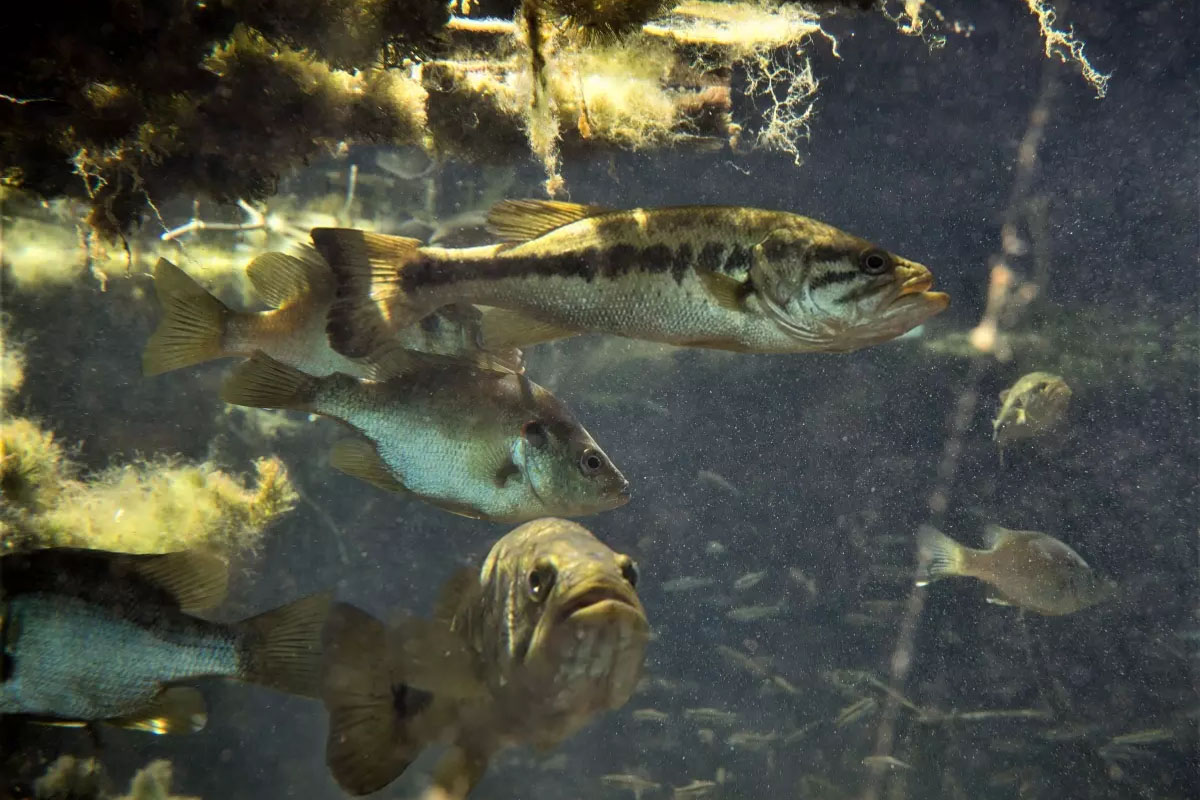
The following are habitats where you can catch Largemouth Bass:
- Freshwater Weed Beds
- Gradual Shores
- Lake and Pond Fishing Holes
- Inlets and Outlets
- Open Water
- Piers, Docks and Pilings
- Shoreline Shallows
- Springs Holes
- Sunken Objects
- Walkways and Bridges
Largemouth Bass Habitat by Season
Largemouth bass will move throughout a body of water to find food, to spawn, to preserve energy, and to seek cover from the elements. The following chart outlines the different habitats where you’re likely to find largemouth bass during each of spring, summer, fall, and winter. Depending on your region, seasonal movement patterns will vary.
| Season | Habitat |
|---|---|
| Spring | During the spring largemouth bass move into the shallows to spawn. Look for flat areas near coves with sandy bottoms. Largemouths are looking for a safe spot they can fan out to build a nest. During spawning season largemouth bass will often make aggressive strikes at lures in an attempt to guard their nest. |
| Summer | As spring transitions into summer and water temperatures rise, bass begin to migrate to deeper waters. During early morning and later evening you'll still find some largemouths feeding in the shallows, but for the majority of the day you'll have better luck fishing off shore stucture including humps, points, holes, piers and vegetation. |
| Fall | As summer subsides and fall approaches, largemouth bass generally move back into the shallows to feed on minnows, shiners and other baitfish. During this time minnow and baitfish immitation lures are effect. Windblown shores with structure or cover where bass can hide are hot spots. You'll also find largemouths hold up near inlets, mouths of creeks and canals, ledges and drop-offs. Look for areas where a bass can hide to ambush baitfish. |
| Winter | As winter approaches and water temperatures dip below 50 degrees, bass retreat to deep water. Focus on deep structure, dropoffs near creek beds, main lake points, humps and traditional cover (e.g. tree stumps, brush piles, etc.) During the coldest months, bass will often congregate along bluffs, rock walls, and ledges where the water is warmest. When fishing shallow lakes or lowland reservoirs target holes, ditches and the deepest areas next to cover. |
When to fish Largemouth Bass
Largemouth bass can be fished year round. However, they are more active, and likely to bite during certain times of the year. As you consider when to go fishing for Largemouth bass, remember, these are cold-blooded fish. They’re going to be more active when water temperatures are a bit warmer and less active as temperatures cool drammatically. As a rule of thumb, you’re going to catch more bass during warmer weather.
Not surprisingly, summer tends to be the best time of year for Largemouth bass fishing. However, summer fishing conditions for Largemouths will vary regionally. Florida, Texas, Lousiana, South Carolina and other southern states are going to experience a longer more productive fishing season than more northerly states such as Michigan and Pennsylvania.
During the late spring and summer, early mornings and evenings are typically the best time to catch largemouth bass as they will try to escape the heat by taking shelter during the day. During hotter summer months, bass tend to be more active during the hours of the day when the water is cooler and the sun is not as strong.
As water temperatures cool off in late fall into winter, Largemouth bass’ metabolism slows and they become less active. During winter months, your best bet for catching largemouths is when the water is at it’s warmest between about 2 p.m. and sunset. But this time the sun has warmed the water a little, baitfish are active, and bass can feed.
Largemouth bass can also be targeted at night. Bass will often head for the shallows after dark in look of small bait fish and other morsels. At night, the best place to fish largemouth bass is along the transition where deep water is closest to the shoreline.
How to catch Largemouth Bass
The most popular methods for catching largemouth bass include bait casting, drift fishing, still fishing and top water fishing using jigs and artificial lures. Another effective fishing technique for catching largemouth bass is “dragging”.
Dragging is a popular method that includes using a plastic bait and a Carolina rig. The technique is performed by smoothly dragging the rig across an open target area. This works best in areas without a lot of vegetation. In areas with a lot of grass, anglers should try wacky fishing with worms. Another effective largemouth bass is the Ned rig. The ned rig is simple, but catches bass every time. There are multiple techniques for fishing a Ned rig.
While less popular, fly fishing is a tried and proven method for catching largemouths. If you’re a fly fishing aficionado, this just may be the technique for you. When fly fishing for largemouths, heavy gear is advised. Brightly colored flies usually help catch the fish’s attention. Use weighted flies in the late summer to help reach the deeper areas where the bass tend to congregate as the water temperatures cool.
The following are the most popular methods and techniques for catching Largemouth Bass:
| Fishing Method | Description |
|---|---|
| Cast and Retrieve | Use a baitcaster or spinning reel to cast and retrieve a bait through a target area. Ideal for spot fishing around cover and areas where you know largemouth bass are hiding. A baitcaster is ideal for heavier line and lures. A spinning reel is better for lighter fishing tackle. |
| Drift Fishing | Drift fishing for bass is an effective method when trying to cover an open area on a river or lake. Allow the motion of your boat to drag or 'drift' your preferred bass rig or presentation along the bottom or through the water column. |
| Still Fishing | Largemouth bass can be caught using a still fishing method where you allow your bait to suspend in the water column near the bottom. As largemouth bass are predatory fish, still fishing works best with live bait such an earthworm or minnow that produces movement. Effective for fishing a specific spot. |
| Top Water Fishing | A fun surface fishing method for bass that produces explosive surface strikes. Retrieve your bait across the surface using a 'walk the dog' or similar technique. Effective topwater fishing lures include walking baits, poppers and prop baits. |
| Trolling | While unconventional and prohited in major bass tournaments, trolling is an effective method for targeting largemouth bass holding to deeper structure and along submerged weed lines. Recommended bass trolling lures include crankbaits, swimbaits and spinnerbaits. |
Best Lures, Bait & Tackle to catch Largemouth Bass
Jigs, plugs, spinners, minnows, and artificial lures are all effective for catching largemouth bass. Other good bait choices include crankbaits, jerk baits, hoppers and bass fishing rigs. When using flies, choose those with colorful or shiny streamers.
The following are fishing lures, bait and tackle that can be used to catch Largemouth Bass:
The best lures for fishing largemouths will vary from season to season as water temperatures fluctuate. The following chart provides recommended lures for differents seasons, water temperatures and water clarity.
| Season | Water Temperature | Clear Water | Muddy Water |
|---|---|---|---|
| Winter | 30-40° | jigs, jigging spoons, spinnerbait, grups | spinnerbait, jibs, crankbait |
| 40-50° | jigging spoons, finesse crankbaits, | shallow crankbait, square-bill crankbait, spinnerbait | |
| 50-60° | shallow crankbaits, spinnerbaits, jigs, jerkbaits , swimbaits | shallow crankbait, square-bill crankbait, spinnerbait, lipless crankbaits, creature baits | |
| Spring | 60-65° | crankbaits, shallow diving crankbaits, lipless crankbaits (flats with isolated weeds), square-bill crankbaits (sloping banks and timber cover), topwaters, jerkbaits, creatures, finesse jigs, spinnerbaits | spinnerbaits, crankbaits, soft plastics, jigs, buzzbaits |
| 65-70° | topwaters, crankbaits, jigs, spinnerbaits, creatures, frogs | jigs, plastics, frogs, buzzbaits, crankbait, spinnerbait | |
| Summer | 70-75° | crankbaits, spinnerbaits, jigs, buzzbaits, frogs, creature baits, worms, deep diving crankbaits (when fishing deeper waters), neko rig, drop-shot rig | crankbaits, spinnerbaits, soft plastics, jigs, buzzbaits, deep diving crankbaits (when fishing deeper waters), neko rig, drop-shot rig |
| 70-80° | shallow crankbaits, worms, spinnerbaits, jigs, buzzbaits, frogs, creature baits, topwaters, drop shot rigs, jigging spoons, swimbaits | shallow crankbaits, spinnerbaits, soft plastics, jigs, buzzbaits, large soft plastics and worms, diving crankbaits | |
| Fall | 50° or below | jigging spoons, blade baits, slow rolled spinnerbaits, jerkbaits, lipless crankbaits | slow spinnerbaits, crankbaits |
| 50-60° | bladebaits, crankbaits (medium diving), finesse crankbaits, buzzbaits, jigs, spinnerbaits, bladebaits, swimbaits, worms | crankbaits (medium diving), spinnerbaits, jibs, buzzbaits | |
| 60-70° | lipless crankbaits, spinnerbaits, shallow crankbaits, offshore jigs, blade baits | lipless crankbaits, crankbaits, spinner baits, buzzbaits, jigs, frogs, worms |


